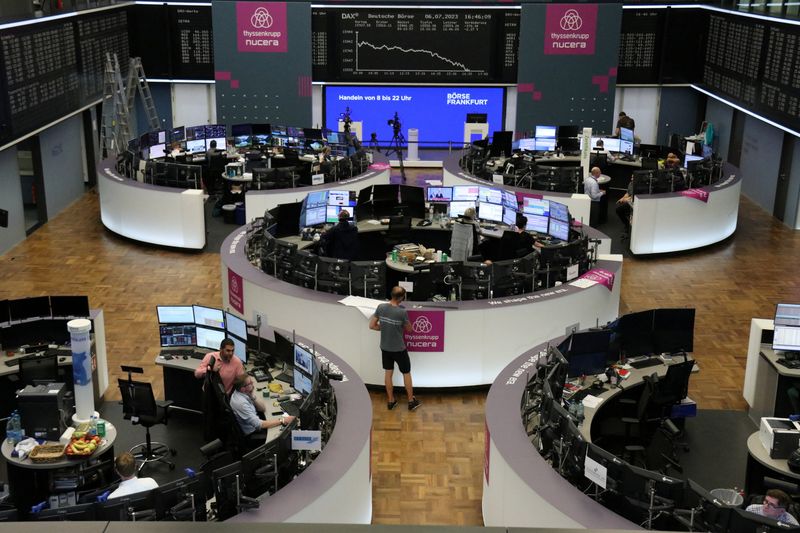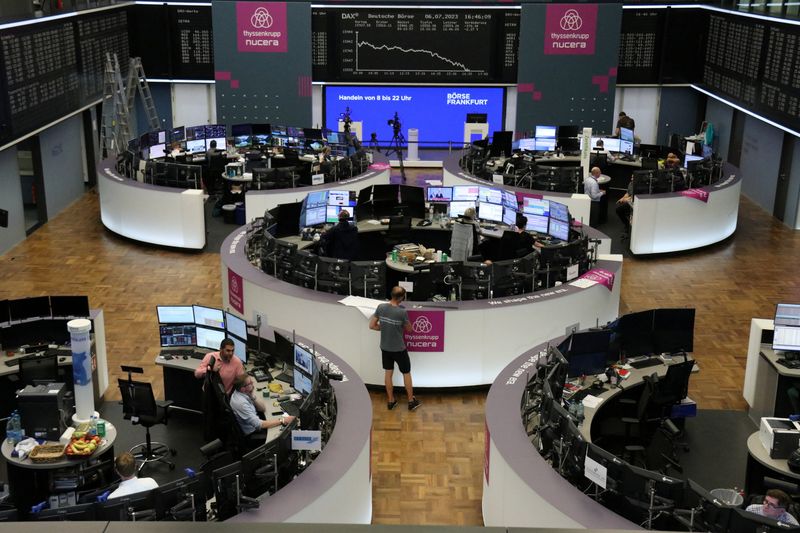Economy
Analysis-China slowdown prompts export-reliant Europe stocks rethink


© Reuters. A worker decorates the Frankfurt stock exchange with Nucera logos for the upcoming IPO of Thyssenkrupp’s hydrogen division Nucera as the German share price index DAX graph is pictured at the stock exchange in Frankfurt, Germany, July 6, 2023. REUTERS
By Joice Alves
LONDON (Reuters) – A lack of clarity on Beijing’s planned stimulus measures will mean a mixed appetite for European stocks over the rest of 2023, investors say, with China the EU’s third biggest export market.
From high-end cars to luxury watches, Europe’s consumer discretionary and staples, technology, industrials and materials sectors all have significant revenue exposure to China.
So with a post COVID-19 recovery in the world’s second-largest economy losing momentum, investors are eager for details on policy support promised by Beijing to spur growth.
Lifting COVID restrictions in China was one of the key drivers of a rally in European equities earlier this year, but its economy is now sputtering.
Services activity in China expanded at the slowest pace in five months in June, while factory activity declined for a third straight month in June.
China faces challenges on many fronts, including a shrinking and aging population, debt-laden local governments, a property downturn and renewed geopolitical tensions.
“China reopening will likely be a headwind when they were actually a major tailwind in the first five months of the year,” said Karim Chedid, Head of the Investment Strategy for iShares at BlackRock (NYSE:) for EMEA.
“But let’s see if the policy stimulus changes things.”
European equities have responded accordingly.
The MSCI Europe index rose 10% in the first quarter, but by just 1% in the second, before it began declining as the outlook clouded.
China, the European Union’s third biggest export market after the U.S. and Britain, accounts for some 15% of the sales of companies in the MSCI UK and MSCI Germany indices, Barclays (LON:) calculates. French, Swedish and Swiss sales to China are 10%.
The EU exported more than 70 billion euros of products to China from January to April, figures released in June showed.
Clingendael, a Dutch think tank, estimated that last year, more than half of Rio Tinto (NYSE:)’s revenues came from China, the world’s biggest importer of raw materials. Rio’s shares have declined more than 12% so far this year.
On the consumer front, Clingendae estimates one third of luxury watchmaker Richemont’s revenues; a fifth of sports apparel company Adidas (OTC:) revenues and a fifth of luxury carmaker BMW revenues came from China.
Emmanuel Cau, head of European equity strategy at Barclays, who in May recommended taking some profit on China-sensitive stocks, upgraded the highly China-exposed European mining sector after the government unveiled stimulus measures.
“Better news in China now should be good news for Europe too,” Cau said.
But BlackRock’s Chedid is not convinced policy measures, which include interest-rate cuts, will be a game-changer.
WHICH STIMULUS?
Sources involved in policy discussions told Reuters that China’s stimulus will target shoring up weak demand in the consumer and private sectors.
Barclays economists expect any policy support in China to be mostly focused on supporting demand in services and boosting investment across technology, manufacturing and infrastructure, especially around data centres and green energy.
Goldman Sachs (NYSE:) economists believe headwinds in China will likely persist, as moderate policy easing this year will only partially offset challenges from the property market and what they call consumers’ and entrepreneurs’ pervasive pessimism.
The bank expects real GDP growth in China to accelerate to 5.4% year-on-year, compared to a global rate of growth of 2.4%, 1.8% in the U.S. and 0.5% in the euro area.
Fahad Kamal, chief investment officer at SG Kleinwort Hambros, said data from China has disappointed because expectations were too high. He continued to overweight European equities, and trimmed his exposure to China’s mid market.
“It’s still pretty good. The Chinese economy is on track to grow by 5% this year. It’s the world’s second largest economy! What would we give for the UK, or the U.S., or Europe to grow by 5%?” he said.
Luxury stocks have seen resilient demand, with shares in LVMH, Europe’s largest company by market value, up around 25% this year. LVMH, gets a quarter of its revenues from China.
Richemont, Burberry and Moncler, which each make a third of their revenue in China, are all up between 10% and 20% this year.
Shares in semiconductor company BE Semiconductor Industries, which according to Barclays makes around 40% of its revenues in China, have surged almost 70% this year.
Kevin Thozet, a member of the investment committee at Carmignac, said there will likely only be more fiscal stimulus in September or October.
“They (the Chinese government) will need to see more pain in the economy (and) more deterioration in the labour market before they do that,” he said.
Economy
Russian central bank says it needs months to make sure CPI falling before rate cuts -RBC


© Reuters. Russian Central Bank Governor Elvira Nabiullina attends a news conference in Moscow, Russia June 14, 2019. REUTERS/Shamil Zhumatov/File Photo
MOSCOW (Reuters) – Russia’s central bank will need two to three months to make sure that inflation is steadily declining before taking any decision on interest rate cuts, the bank’s governor Elvira Nabiullina told RBC media on Sunday.
The central bank raised its key interest rate by 100 basis points to 16% earlier in December, hiking for the fifth consecutive meeting in response to stubborn inflation, and suggested that its tightening cycle was nearly over.
Nabiullina said it was not yet clear when exactly the regulator would start cutting rates, however.
“We really need to make sure that inflation is steadily decreasing, that these are not one-off factors that can affect the rate of price growth in a particular month,” she said.
Nabiullina said the bank was taking into account a wide range of indicators but primarily those that “characterize the stability of inflation”.
“This will take two or three months or more – it depends on how much the wide range of indicators that characterize sustainable inflation declines,” she said.
The bank will next convene to set its benchmark rate on Feb. 16.
The governor also said the bank should have started monetary policy tightening earlier than in July, when it embarked on the rate-hiking cycle.
Economy
China identifies second set of projects in $140 billion spending plan


© Reuters. FILE PHOTO: Workers walk past an under-construction area with completed office towers in the background, in Shenzhen’s Qianhai new district, Guangdong province, China August 25, 2023. REUTERS/David Kirton/File Photo
SHANGHAI (Reuters) – China’s top planning body said on Saturday it had identified a second batch of public investment projects, including flood control and disaster relief programmes, under a bond issuance and investment plan announced in October to boost the economy.
With the latest tranche, China has now earmarked more than 800 billion yuan of its 1 trillion yuan ($140 billion) in additional government bond issuance in the fourth quarter, as it focuses on fiscal steps to shore up the flagging economy.
The National Development and Reform Commission (NDRC) said in a statement on Saturday it had identified 9,600 projects with planned investment of more than 560 billion yuan.
China’s economy, the world’s second largest, is struggling to regain its footing post-COVID-19 as policymakers grapple with tepid consumer demand, weak exports, falling foreign investment and a deepening real estate crisis.
The 1 trillion yuan in additional bond issuance will widen China’s 2023 budget deficit ratio to around 3.8 percent from 3 percent, the state-run Xinhua news agency has said.
“Construction of the projects will improve China’s flood control system, emergency response mechanism and disaster relief capabilities, and better protect people’s lives and property, so it is very significant,” the NDRC said.
The agency said it will coordinate with other government bodies to make sure that funds are allocated speedily for investment and that high standards of quality are maintained in project construction.
($1 = 7.1315 renminbi)
Economy
Russian central bank says it needs months to make sure CPI falling before rate cuts -RBC


© Reuters. Russian Central Bank Governor Elvira Nabiullina attends a news conference in Moscow, Russia June 14, 2019. REUTERS/Shamil Zhumatov/File Photo
MOSCOW (Reuters) – Russia’s central bank will need two to three months to make sure that inflation is steadily declining before taking any decision on interest rate cuts, the bank’s governor Elvira Nabiullina told RBC media on Sunday.
The central bank raised its key interest rate by 100 basis points to 16% earlier in December, hiking for the fifth consecutive meeting in response to stubborn inflation, and suggested that its tightening cycle was nearly over.
Nabiullina said it was not yet clear when exactly the regulator would start cutting rates, however.
“We really need to make sure that inflation is steadily decreasing, that these are not one-off factors that can affect the rate of price growth in a particular month,” she said.
Nabiullina said the bank was taking into account a wide range of indicators but primarily those that “characterize the stability of inflation”.
“This will take two or three months or more – it depends on how much the wide range of indicators that characterize sustainable inflation declines,” she said.
The bank will next convene to set its benchmark rate on Feb. 16.
The governor also said the bank should have started monetary policy tightening earlier than in July, when it embarked on the rate-hiking cycle.

 Forex3 years ago
Forex3 years agoForex Today: the dollar is gaining strength amid gloomy sentiment at the start of the Fed’s week

 Forex3 years ago
Forex3 years agoUnbiased review of Pocket Option broker

 Forex3 years ago
Forex3 years agoDollar to pound sterling exchange rate today: Pound plummeted to its lowest since 1985

 Forex3 years ago
Forex3 years agoHow is the Australian dollar doing today?

 Cryptocurrency3 years ago
Cryptocurrency3 years agoWhat happened in the crypto market – current events today

 World3 years ago
World3 years agoWhy are modern video games an art form?

 Commodities3 years ago
Commodities3 years agoCopper continues to fall in price on expectations of lower demand in China

 Economy3 years ago
Economy3 years agoCrude oil tankers double in price due to EU anti-Russian sanctions





















